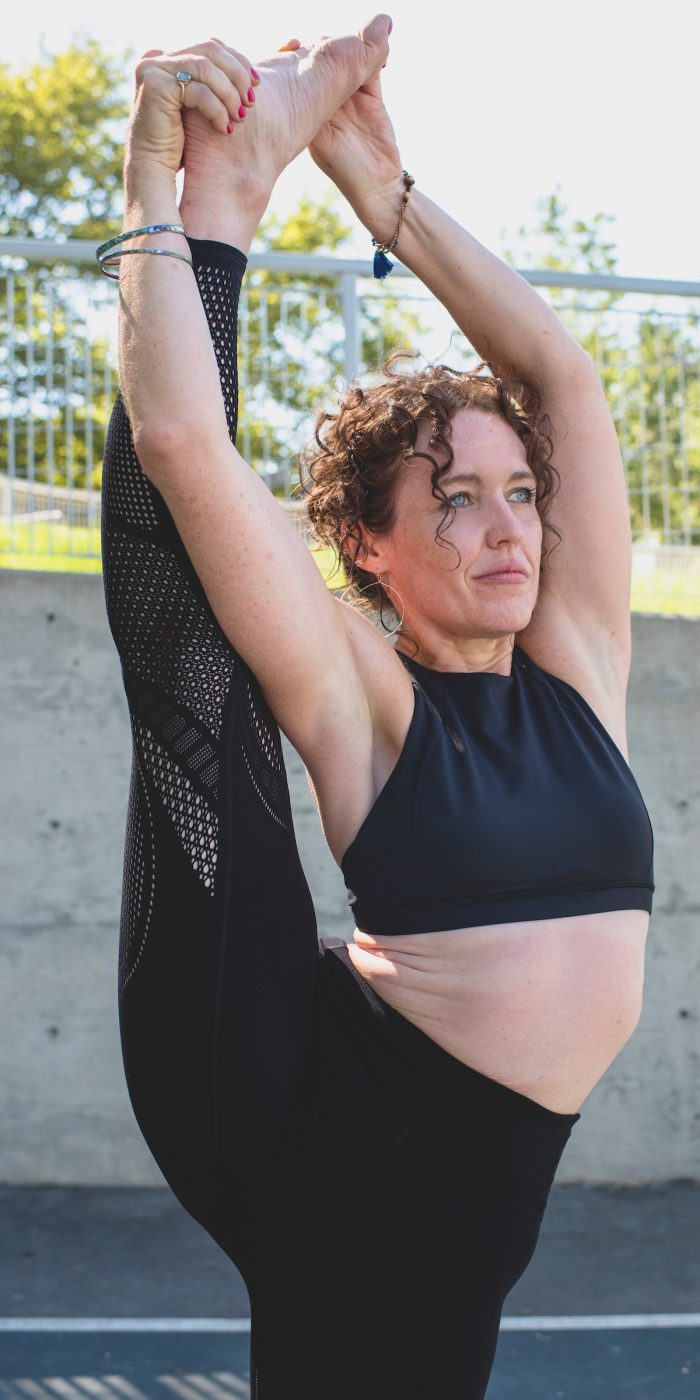Last year, Lisa Martinez, a yoga instructor based in Northern Virginia, stood before a large crowd who gathered at the Arm Balance and Inversions Workshop she was leading at the Spark Yoga studio. The room was abuzz with excited yogis in training who wished to master the handstand. The animated chatter died down as Martinez addressed the participants. In a hushed tone, she soulfully told the participants her tragic story; how she crumbled under the weight of her despair and how the practice of yoga, ultimately, saved her life.
I was present at this workshop and was moved by her ability to express and share such vulnerability with our group. As an avid fan and student of Martinez, I approached her after class and she agreed to meet with me in her home. We got together and talked over plates of raw vegetables in front of a blazing fireplace in her living room. I complimented her leggings, black with bursts of starry specks and swaths of purple hues reminiscent of space, a place beyond time itself. She told me how they remind her of home in Wisconsin, how one could look up at the night sky there and see millions of stars. It’s something Martinez didn’t realize she would be missing as she moved from state to state, and even to a new country.
Martinez described how she grew up in a strict Christian household. She met her husband in college and 10 months after their wedding, Lisa gave birth to their eldest son. In the next few years, Martinez would have three more sons, including her youngest, Benjamin. She describes Benjamin as a precocious toddler, with the brightest blue eyes and two front teeth that inspired the nickname “Benny Rabbit.” She motioned to a photo of her son on the mantel. He was smiling in the photo and Martinez told me how she loves the photo because it is reflective of his cheerful temperament.
Martinez’s husband was a Marine and the family was stationed in a small town in Georgia. One day, Martinez decided to treat her sons to a trip to Walmart and to take her van to the shop for repairs. At the garage, Martinez thought she had all four of her young boys accounted for, but realized that Benny, who was only 18-months-old at time, was missing. Moments later, tragedy hit as she learned that her youngest was run over by a garage employee and was killed instantly.
With tears in her eyes, Martinez told me, “I ran to him and my world completely fell apart.” Martinez recalled that in the days following Benny’s death, people had asked her if she was in an accident herself because she was covered in bruises. Martinez said, “Apparently it’s because I was just throwing myself down on the ground in heart wrenching, soul tearing grief.”
Martinez found it impossible to go back to everyday life, blaming herself for her son’s death. She said, “There was a thought that if I hadn’t been his mother, he wouldn’t have died. It was an overwhelming sense of how much it was my fault.” She stopped eating because she felt that she did not deserve to eat. She did not feel any anger towards the garage employee, since she believed that Benny died due to her own neglect. Martinez stopped sleeping because she was plagued by horrific images and memories of the event. She said, “How can I just go throughout the day and teach [the children] to read and do laundry and cook dinner when I have these images playing in my head of the death of my son? It just doesn’t make any sense.”
Martinez knows now that what she was going through was symptomatic of Post-Traumatic Stress-Disorder (PTSD), but was misdiagnosed for years, told to focus on coping with her grief, rather than target her symptoms.
Martinez said, “I would tell everyone about my symptoms, [the feeling of] ice in my veins, extreme fear at small things, and no one was really helping me with that. I was telling people that I thought I was having a heart attack and they would tell me, ‘you’re fine.’ No one helped me understand that there are chemical reactions and that I needed to develop skills to deal with these reactions.”
Martinez’s husband bought her a Rodney Yee yoga DVD to help her resolve her insomnia. Martinez described pairing this introduction to yoga with Christian music, which helped see the benefits of integrating mind and body in her yoga practice.
The next few years were marked by many challenges that all seemed to center around the trauma of losing Benny. The family moved several times, including a move to Mumbai, India to do charitable work with sex trafficking victims.
Upon their return to the United States, the family moved in with Martinez’s family, since they had sold all of their possessions prior to their move. Stress had taken its toll on her marriage and after a particularly significant fight, Martinez’s husband left her and took the children with him.
Shortly thereafter, Martinez became suicidal. She had never made an attempt, but she would constantly threaten to take her life. Martinez remarked, “A month later after coming back from India, I found myself in a psych ward. With my family gone. In a city I never lived in. But that, I say, is where my healing began.”
After some time, Martinez was discharged from the facility. Eventually, Martinez and her husband reconciled and were able to save their marriage. “We had gone through the trenches together,” Martinez said, “and we were able to understand and love each other anyway.”
Martinez shared that throughout the ordeal, it became clear to her that yoga was what helped her calm down in ways that traditional talk therapy didn’t achieve. She told me, “when Benny died, I was in my own universe of pain that, I felt, nobody, not even my husband, could understand. But with yoga, the process of breathing and integrating my breath with what I am feeling, understanding spiritually, and the movement of my body all together in one, just really started to affect me.”
Renee Groenemann, an Ohio based mental health counselor, specializes in trauma work and yoga therapy. She spoke with me about the many different ways yoga can be so effective with healing traumatic memories and why Martinez’s practice of yoga helped her heal.
Groenemann explained that while experiencing a traumatic event, individuals undergo the fight, flight or freeze response. When the body enters this response, the breath becomes shallower, changing the heart rate variability, which is the measurement of variability of time between beats of the heart. This change results in the traumatized body becoming more rigid. Groenemann said that the goal is to help the body become more fluid. One way of doing this is through breath work, as breath is directly related to the nervous system. By changing breathing patterns, Groenemann said, “we can hijack the system.”
The nervous system is made up of the sympathetic nervous system and the parasympathetic nervous system. “The sympathetic nervous system is activating, so that’s what gets triggered when there’s danger around, and the parasympathetic nervous system is the calming part,” Groenemann said. “We can actually use the breath to start bringing the calming in more actively and to bring more fluidity to the system through the heart rate variability changes. By taking a breath, we actually can take over this responsiveness in the system between the sympathetic and parasympathetic nervous system.”
Because of the way memories of the trauma are uniquely stored, it can be easily activated, causing people with trauma to get triggered. Groenemann said, “If anything triggers from that memory, then we are shifted very quickly into that old experience – it’s like we lose track of the current moment and we swing into that experience very quickly for survival reasons.”
Yoga allows people to cope with triggers through the practice of mindfulness and being attentive to the present moment. If a traumatic memory is triggered in a safe space like in a yoga class, Groenemann said, “we tap into our yoga skills while we are triggered and the more positive memory of being okay while recalling that traumatic memory gets stored. So it’s very valuable and starts reworking the trauma over time.”
Groenemann explained, “Through this process of paying attention to our bodies, learning to listen inwardly to body sensations, we are able to become mindfully aware of the present moment. Even if we are triggered by something, it’s a little easier for us to be aware that we are safe right now. So we end up able to rework the old memory by carrying it constantly with the safe present moment.”
Groenemann shared that the yoga poses themselves can also help rewire the traumatized brain. Groenemann said, “When I’m in the postures, I pay attention to what’s happening in my body so I’m using that inner awareness to heal . By purposefully activating different positions in the body, the brain starts rewiring as well.”
Martinez decided to pursue a teacher training and ironically, as Martinez watched her instructors do handstands, she laughed to herself, thinking she would never possess the ability to do one. But with hard work and practice, she succeeded, proving to herself that she was more capable than she previously thought. Including coping with her son’s death.
“I like to do a handstand because it helps me feel capable and strong in life when I don’t feel very capable and strong,” explained Martinez, “the days that you’re struggling, you stand a little bit and that feeling of agency gives you the ability to say, ‘I can make a choice and make a change in my life.’ When people feel like they are victims all the time, [it is vital] to have that sense of agency so that they could say, ‘I’m capable, I’m strong. I may have failed, but I practiced and I finally did it.’”
Martinez will never stop missing Benny. But for her, giving up was a choice, but never an option. She said, “I take a breath and make the choice, no matter how much I don’t want to, I go in another direction.”
 Share on bsky
Share on bsky




Read 0 comments and reply